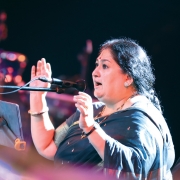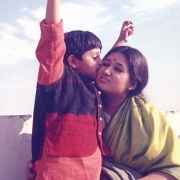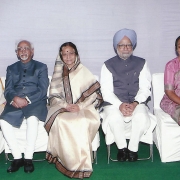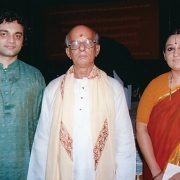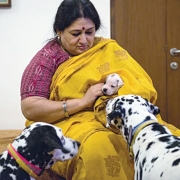
People
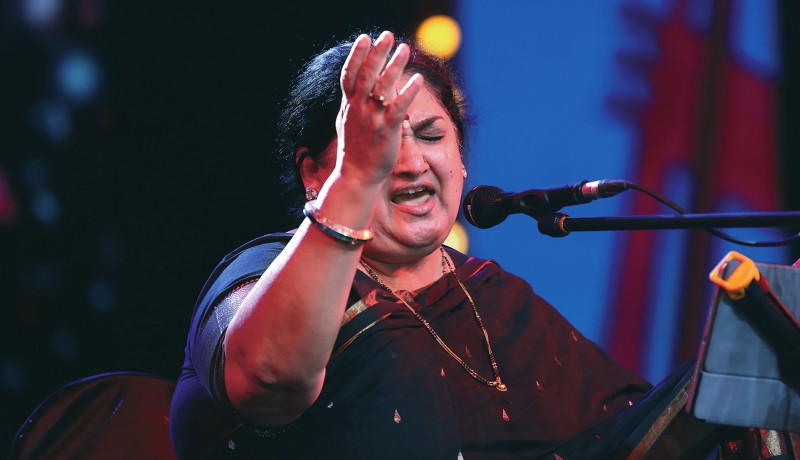
Renowned Hindustani classical vocalist, composer and fusion music exponent Shubha Mudgal is an artist with a diverse repertoire, writes Rachna Virdi
Rockstar of classical music, queen of fusion and powerful songstress are just some of the epithets associated with Shubha Mudgal. Yet, none of these do justice to the versatile singer who has broken barriers with élan, winning hearts with pop and Hindustani classical music while anchoring her roots firmly in classical music. Known for her bold voice and mastery of Vaishnava and Sufi poetry, Mudgal’s repertoire includes folk, pop and other forms of popular music. Indeed, versatility and adaptability are the hallmarks of her persona.
Harmony-Celebrate Age met the celebrated Hindustani vocalist after her enlivening performance at Paddy Fields—a two-day music festival held in Mumbai recently—where her power-packed rendering of Dholna had the audience on its feet. Clad in an earthy sari, her trademark kohl-lined eyes lighting up, Mudgal reflected on life, musical influences and causes close to her heart. “Paddy Fields focuses on the revival of folk music and gives talented musicians from rural and urban India a common platform,” she noted. “This time, the theme was ‘saluting women performers’. It’s always a pleasure to share the stage with colleagues, more so this time as we had only women voices.”
Mudgal credits her musical journey to her parents Skand Gupta and Jaya, who taught English literature at Allahabad University and loved Hindustani classical music. “My mother wanted us to follow an interdisciplinary approach,” recalls the singer, who along with her sister learnt Kathak at an early age and Hindustani classical music at the age of 17. Though Mudgal learnt music from vocalist Kamala Bose for a year, it was her intensive training under Pandit Ramashreya Jha, head of the department of music at Allahabad University, which laid the foundation for her career. “I first learnt music from Jhaji in 1978 in Allahabad and, occasionally, later after moving to Delhi, sometime in 1982.”
In Delhi, Mudgal trained under Pandit Vinay Chandra Maudgalya, founder of Gandharva Mahavidyalaya, for eight years and subsequently under other stalwarts. After graduation, her mother suggested she take a year off to decide if she wanted to pursue music as a career. “It was a path-breaking gesture,” she shares. “I took my decision in a month and my parents supported it wholeheartedly.” Mudgal performed occasionally in Allahabad and later in other parts of India.
Over time, Mudgal forayed into pop with Ali More Angana, a collection of Sufi songs that became wildly popular with the foot-tapping title track a rage at discotheques. “There’s no age bar in music. The power of music is such that it takes the most unlikely people into the hearts of someone,” says the singer, whose byword is experimentation.
She further endeared herself to the younger generation with tracks such as Dholna, Ab ke sawan and Mann ke manjeere, besides collaborating with popular bands such as Indian Ocean and Euphoria. Meanwhile, Mann ke manjeere caught the fancy of Breakthrough, a Delhi-based human rights organisation, which used it as an anthem for a campaign to promote and protect women’s rights. “It breaks my heart to see women being subjected to violence and sexual assault,” admits the 58 year-old. “I think the status of women today is a highly complex and conflicted one.”
EXCERPTS FROM THE CONVERSATION
How did your musical journey begin?
To appreciate my musical journey, it’s important to understand our family background. My maternal grandmother, born in 1900, loved music and wanted to learn it but her father considered it unrespectable. He told her he could arrange a piano teacher but not someone to teach her Indian classical music. As my grandfather passed away early, my grandmother brought up my mother and her two sisters single-handedly. She gave them the chance to participate in theatre and learn music, though she was not keen to let them pursue it professionally. My own parents were deeply respectful of the arts. My sister and I were taught that we couldn’t walk past musical instruments with our shoes on; we were also told to clean the instruments regularly and respect them. We continued to study and listen to music even during our exams. My parents were very encouraging. If it wasn’t for their unconditional support, I would not have been a musician.
Who were your musical influences?
After my parents, I am most thankful to my gurus. Following my training under Pandit Ramashreya Jha and Pandit Vinay Chandra Maudgalya, I took further training under Pandit Jitendra Abhisheki, Pandit Kumar Gandharva and Pandit Vasant Thakar. I also got some taleem [training] in thumri-dadra [semi-classical forms] under Srimati Naina Devi. Each one of them opened up their homes to me and taught with the greatest generosity. Today, we talk of institutions where people pay very heavy fees and learn but in the guru-shishya tradition, no fee is charged. You go to the guru; if you are accepted, you become a part of the extended family. Having said that, it’s not always easy for the guru or the shishya. You could have a music class that could go on throughout the day or you could be hanging around without any class. Informality is the strength of the system and if someone doesn’t belong there, it can be frustrating. It was a new learning; at times, I would complain to my mother but there was no question of changing the training schedule!
How did training under different gurus aid your evolution as a musician?
Gurus are like musical parents; you inherit a lot of their features and resemble them in many ways. The eclectic approach of learning from many sources and absorbing various influences did not come as a spark of inspiration for me. When you are learning music, you cannot go hopping from one style to another. It’s only when you have reached a particular stage that you can seek permission from your guru to go to other gurus. That’s an unwritten rule in music.
What do awards mean to you?
It’s reassuring to win awards. But at the end of the day it is a pat on the back from the guru that is worth many such awards. There are times you realise you are indeed lucky to get awards despite the presence of distinguished senior musicians. For instance, I was honoured with the Padma Shri in 2000, but my guru Pandit Ramashreya Jha did not receive a Padma award. Now, if I refuse to accept the award because my guru had not been given a Padma award, would that get him an award? All I can tell myself is that it is with the guru’s blessings that I have come this far.
Do you think the music industry is driven by nepotism and exploitation?
Many of our greatest singers have been part of the industry. So, I don’t see why we should complain of nepotism. Exploitation often happens because people con themselves into believing something. If you don’t know what you want, you don’t stand a chance in the professional world.
In today’s scenario, do you think traditional music has to evolve to retain its appeal?
Traditional music has its own appeal and will survive as long as there are people who love it and listen to it. Why do you think so many people attend Hindustani classical music concerts? Why is dhrupad [a genre of Hindustani music] so popular in Europe? However clichéd it may sound, music is universal. Foreign artists play to full stadiums in India; when we are invited overseas, people of all orientations attend our concerts. That’s the power of music. It’s fine if 50,000 or 500,000 people listen to film music and only 5,000 or 500 listen to classical music. But there should be space for those 5,000 people.
As an artist, you have never shied away from experimentation.
Fusion music wasn’t really my experiment. In 1996, I sang and recorded non-classical music at the invitation of composer Jawahar Vatal for the album Ali More Angana. Later, it was Shantanu Moitra who invited me for Ab ke sawan. As the initiative has always come from composers, I can’t take credit for being experimental. Every artist experiments or explores in their own way.
Being a woman, is it harder to achieve success in what many regard as a male-dominated industry?
I never thought I’ve been held back because I’m a woman. At times, I may choose to sort of let a bias or prejudice go by because I don’t want friction, but in my own home women are deeply respected. Also, I don’t think terms and nomenclatures matter as long as you’re good at what you do and prove yourself. There have been great women singers such as Mogubai Kurdikar and Kesarbai Kerkar who didn’t have ‘ustad’ prefixed to their names but remain deeply respected. Sometimes we tend to over-sensationalise the gender bias. Being a musician is tough for both genders. I cannot say my struggle is greater than those of men because I believe we are equals.
Tell us about the role women have played over the years in keeping music, the arts and traditions alive in India.
In Hindustani classical music, women have played a very important role particularly in promoting specific song forms and genres like thumri and dadra. A century ago, women performers in the public gaze came from communities that were not considered respectable. So there was a particular community or class of women who were professional women music-makers. They were greatly respected and admired for their art but had a huge social stigma attached to them. As a student of music, I have the deepest respect for those women who bore the brunt of the stigma and made it possible for us to become professional women musicians.
What are your concerns about our society today?
It has been proven time and again that people who’ve had an involvement and engagement with the arts tend to be more sensitised towards society. However, if that is so, why don’t we have an arts education programme in our education system? When I say arts, I mean all forms of it, from films to the most esoteric arts. In 2005, I was part of the focus group that studied the issue with the National Council of Education Research and Training (NCERT), where the need for a vibrant arts education programme was discussed. But even today, arts activity is kept only for the annual day when a very slickly packaged programme is presented. I do not expect an army of children to start singing raga Darbari or do tillana. But access to the arts would be a step towards creating a more sensitised society.
You have been vocal about the causes you believe in.
I feel I cannot isolate myself from what is happening around me. However, I’m so involved with my music that I am not able to be an activist in the real sense of the word. But yes, I’ve been vocal about causes such as communal harmony. I perform with musicians of different religions and see how the power of music transcends all these so-called differences. The wahs and the aahs come for anybody who plays music well, irrespective of their community and caste.
What do you feel about the status of women today?
[Thinks] Last night at the Paddy Fields festival, I sang a folk song that goes like this: Sasu mori kaheli banjhiniya, nanad brijwasan ho, rama jinki me bari re biyahi uhi ghar se nikalan ho (my mother-in-law has declared me barren; my sister-in-law declares I am fit only to live in Vrindavan and the man who I was married to has turned me out of the house as I cannot bear children). The lady finds herself in the middle of a jungle, face to face with a tigress. The song goes: Dukh sukh puche ho (the tigress asks what has happened). The lady recounts her story and asks the tigress, “Why don’t you eat me up?” The predator replies, Jahava se ayo ulat waha jao (go back to where you came from because if I eat you I might turn barren myself). As the song goes, the lady meets a serpent, devi [goddess] and dharti [the earth], and all of them refuse to embrace her because she’s barren. What a surreal and tragic story! In 2018, we might feel it’s just a song but such deep prejudices and biases against women still exist in India.
Ageing women are even more marginalised in our society. How can they remain relevant and active in their silver years?
It’s a lovely world we live in; there are lots of possibilities of learning from each other. Why should technology be only for the young and not for anyone who’s willing to use it? If you’re open to changing times, it is possible to remain connected with the world. Why can I not celebrate youthful voices rather than feel insecure about them? And yes, like me, my voice is ageing, so understanding the limitations and turning them into strengths are important to me. There’s wisdom, experience and quality in old voices, which no amount of youthfulness will have. I still have fun singing Ab ke sawan. But if my voice starts shaking and I continue to sing at the same pitch, it is pointless!
You recently curated the Living Traditions concert, which sought to introduce today’s audience to yesterday’s musical glory.
I’ve been a music curator for Serendipity Arts Trust in New Delhi that organises the Serendipity Arts Festival in Goa, which is about multiple arts like dance, music, photography, visual arts, theatre, culinary art, etc. We feel we need to respect classical music because it’s old. But its antiquity should not be the sole reason to respect it. Today, I’m being called contemporary but 100 years from now, I’ll be called traditional. Tradition is like a river, it’s constantly changing. If it doesn’t, it will become stagnant. I wanted to show how changes occur in music and make a connection between the past and the present. When you hear a young musician interpret something that was recorded 100 years ago, the connection with the past is evident as the changes are easily depicted.
You set Premghan’s poetry to music…
Over the years, I’ve inherited a lot of compositions and repertoire and created my own too. My husband Aneesh, a composer and tabla player, and I study and work on several themes including Premghan’s poetry. Premghan was a poet in the Mirzapur area in the 19th century and an important figure in the development of Hindi literature. We collaborated with Oddbird Theatre in Delhi for a musical presentation of Premghan’s poetry. For us, it was a lovely beginning!
You set up Underscore Records along with your husband. What is the intent behind it?
Owing to my fascination with Internet technology, I noticed early on that it is possible to publish and distribute one’s music independently. Around that time, as we travelled for concerts and met wonderful musicians, it was appalling to know that many of them were never recorded. So, to facilitate access to their music for music lovers, we set up UnderscoreRecords.com in 2003. It is a distribution platform that allows musicians to make recordings on their own terms and distribute it; all rights remain with the artists.
How has your partnership with your husband evolved personally and musically?
[Smiles] Aneesh and I met in the early 1990s as musicians; we were colleagues first and we married in 2000. I had heard him play with other musicians and requested him to accompany me on one of my early recordings for a label called Music Today. They were producing a series called ‘Songs of the Season’ in which I was one of the four artists featured. That’s how we started working together. Later, I wanted to set up my website on music and requested him to collaborate as he’s a well-known scholar and writes on music. Gradually, we started noticing common interests and decided to marry. To date, we perform together.
Do you consider yourself a musical influence on your son Dhaval?
You should ask my son this question! I’m happy Dhaval is very fond of music although he’s not a full-time musician. It’s not surprising given his father comes from a musical family and his mother is a musician; it would have been surprising if he had hated music. Music is very much a part of his life. Whether he chooses to make it his profession or not, it’s up to him. I would be supportive of his decision.
Which artists do you listen to?
I enjoy all kinds of music including film music, but I love listening to Hindustani classical music and the great masters of the past. I listen to Bade Ghulam Ali Khan saab, Amir Khan saab and Pandit Kumar Gandharva. I’m a great admirer of Siddeshwari Deviji and Begum Akhtar. I also listen to music recommended by youngsters such as my students, my son and nephew.
What else do you enjoy besides music?
I’m a big foodie, an eggetarian; I grew up in a non-vegetarian home but my sister and I chose to give up eating meat, fish and poultry a long time back. My husband and I enjoy food. As we travel a lot, we get to try different cuisines. If I may say so, I have 32 sweet teeth!
How has age influenced you?
As a musician, it’s important for me to be able to judge when I should stop singing publicly. Of course, we have the example of Kesarbai Kerkar who stopped singing in her prime, saying, “I want people to remember me as I was in my prime.” I know of very few musicians who can do that. Age is a challenge, of course, but when I write down my age I don’t feel a day older than I was five or 10 years ago. At the same time, I know that if I’m huffing and puffing after walking 5 km, it means that my body is telling me something and I have to listen to it.
What’s next for Shubha Mudgal?
In December 2017, I curated some music events for the Serendipity Arts Festival. Besides regular concerts, Aneesh and I are also working on a project called ‘The Bridge of Dreams’, wherein we are collaborating with a band called The Sirens in Australia, along with saxophone guru Sandy Evans, harmonium player Sudhir Nayak and tabla player Bobby Singh. I’ve also just submitted my debut book of short stories to my publisher; hopefully, it should be out in 2018.
AWARDS & ACHIEVEMENTS
- 1996: National Film Award for Best Non-Feature Film Music Direction for Amrit Beej
- 1996: Aadharshila award, instituted by eminent writers, journalists and artists
- 1997: Kalashri award from the Raja Ram Mohan Roy Education Foundation
- 1998: Gold Plaque for Special Achievement in Music at the Chicago International Film Festival
- 2000: Padma Shri
- 2015: Yash Bharati Samman from the Uttar Pradesh government
- 2016: Rajiv Gandhi National Sadbhavana Award for contribution towards promotion of goodwill
THE SOUND OF MUSIC
- Ali More Angana – 1996
- Kama Sutra – 1997
- Arasial – 1998
- Pyar Ke Geet – 1999
- Lajja – 2001
- Kisson Ki Chadar – 2003
- Raincoat – 2004
- Hazaaron Khwaishein Aise – 2005
- Laaga Chunari Me Daag – 2007
- Jahan-e-Khusrau – 2007
- 1920 – 2009
- No Stranger Here – 2011
- Patang – 2014
- Krishna – 2016
Photo courtesy: Paddy Fields Featured in Harmony — Celebrate Age Magazine March 2018
you may also like to read
-
For the love of Sanskrit
During her 60s, if you had told Sushila A that she would be securing a doctorate in Sanskrit in the….
-
Style sensation
Meet Instagram star Moon Lin Cocking a snook at ageism, this nonagenarian Taiwanese woman is slaying street fashion like….
-
Beauty and her beast
Meet Instagram star Linda Rodin Most beauty and style influencers on Instagram hope to launch their beauty line someday…..
-
Cooking up a storm!
Meet Instagram star Shanthi Ramachandran In today’s web-fuelled world, you can now get recipes for your favourite dishes at….



